Audio/video receivers come in a wide range of prices and perhaps the most interesting category right no is the one represented by the Onkyo Pioneer and Yamaha models tested for this comparison Much below $500 the constraints imposed by the sheer number of functions necessary in a Dolby Pro Logic A/V receiver-a stereo FM tuner a surround sound decoder and at least five channels of power amplification-can severely limit the number of features or (more usually) the receiver’s performance. At higher prices, the number of features tends to grow rapidly, if often not usefully, and the question typically is not so much of performance as of convenience and flexibility.
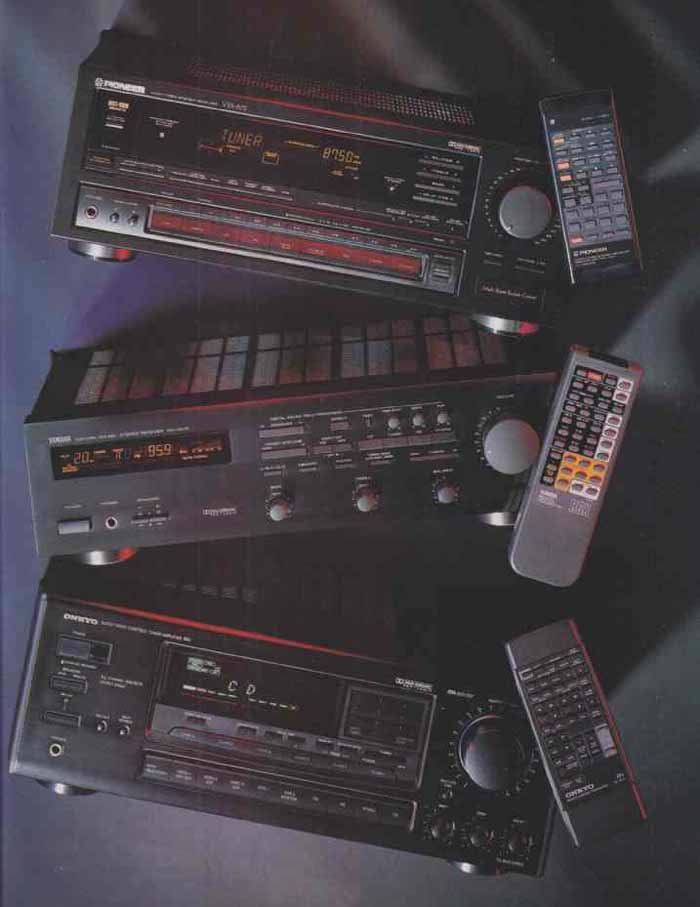
An A/V receiver designer works hardest when designing a model in the $500 range. This is the range where truly adequate amounts of amplifier power can be balanced against the performance and complexity of the surround-sound circuitry and the inclusion of various convenience features. And it is the range where such tradeoffs can show up most clearly.
The receivers we chose to test happening category right no is the one represented by the Onkyo Pioneer and Yamaha models tested for this comparison. Much below $500 the constraints imposed by the sheer number of functions necessary in a Dolby Pro Logic A/V receiver-a stereo FM tuner a surround sound decoder and at least five channels of power amplification-can severely limit the number of features or (more usually) the receivers performance. At higher prices, the number of features tends to grow to illustrate these points very well. As you can see from "Features". they are almost evenly matched in their functionality. For instance, all come with infrared remote controls and have one video-monitor output, connections and switching for two sets of main speakers, a headphone output, and so forth. Even large apparent differences in features often won't prove to be significant in actual use. For example, with "only" thirty radio presets in the Pioneer receiver you can program one out of every three available FM stations. Many-but not all-of the lab test results (see the measurements tables) are equivalently similar or irrelevantly dissimilar.
So far, these three receivers may seem to be created equal, but their equality is unequally distributed. Their designers have opted for slightly different mixes of features, performance, and operating convenience, playing these factors off each other to slightly different effect in each model. You can’t tell that from a cursory glance at either lab results or lists of features. But if you roll up your sleeves and put the receivers to work in a system, as we did, you’ll quickly discover each one’s personality.
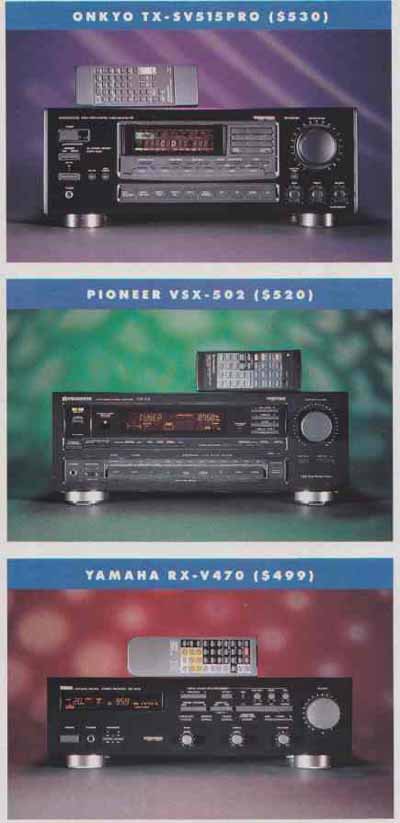
Onkyo TX-SV515PRO
Despite the number of buttons on the front panel, Onkyo’s TX SV5 15PRO is fairly easy to use. That’s because many of those buttons are devoted to tuner functions (such as numerical frequency selection and categorizing and memorizing station presets) and have a clear, nearly self- explanatory logic to them. The only feature that might be tricky to use at first is the ability to select separate sources for listening and recording, which is complicated by the number of different sources that can be selected. The TX-SV515PRO can also be used in a dual-zone mode, in which the surround-channel amplifiers drive a pair of remote stereo speakers. This scheme enables not only separate volume control of the remote speakers, but also selection of a different source from the one playing in the main room. You lose surround sound in the main room when the dual-zone mode is activated, however.
Onkyo’s Dolby Pro Logic circuitry comes with the standard complement of outputs and level-adjustment features (although there’s no mono output for driving a subwoofer). The digital indications of center- and surround-channel level were accurate within 1 dB from + 16 dB (the highest setting) to —16 dB, enough range for almost anybody.
When it comes to music-enhancement modes, the Onkyo really has only one, called Hall. Tests showed that it operates by generating a series of about nine delayed “reflections” through the surround speakers, each reflection approximately 7.4 dB lower than the preceding one. The delay- time control, which has a span of 15 to 30 milliseconds (in 5-millisecond increments) for the single delay in Dolby Pro Logic operation, in this case serves to set the interval between the multiple delays.
In some ways, Onkyo’s Hall mode is similar to the first delay-line ambience-enhancement systems from AudioPulse and ADS, which also generated simple reflection patterns. The austerity of such schemes has always had its good and bad sides, and this one is no exception. On the positive side, because none of the added reflections is sent through the front speakers it is difficult to make pop music sound too spacy, even with the delay time set to the maximum. On the down side, the Hall mode is really beneficial only for jazz, classical music, and pop recordings that contain substantial amounts of reverberation.
Back-panel layout is clear and simple, with the inputs and outputs horizontally arrayed across the span and with video connections directly above their related audio ones. Together these characteristics make for easier cable hookup by feel alone, especially after the receiver has been installed. The binding-post connectors for the main speakers take either stripped cable ends or banana plugs (single or dual). Supplied accessories include simple AM and FM antennas, a special cable that enables the receiver’s re mote to control compatible Onkyo components, and the remote handset. The remote itself is commendably self- explanatory and simple to use. It includes switching for the main speakers, which is always helpful in checking whether the surround-sound decoder or the music-enhancement mode is operating properly.
In many ways, Onkyo’s TX SV515PRO was the best performer sonically. We detected no anomalous behavior in any operating mode. Noise was low, output power was on the high side (though with not much dynamic headroom), and Pro Logic operation was fine in terms of stability and accuracy of sound steering in our standard movie-clip torture tests. In the lab tests, the flatness of the Pro Logic frequency responses was unusually good. In all, the TX SV515PRO is a solid performer with middle-of-the-road features.
Pioneer VSX-502
Flashier in features, the Pioneer VSX-502 has capabilities not shared by either of the other models. Especially noteworthy are its provisions for selecting playback video and audio signals separately, memorizing set tings of the button-controlled bass and treble controls, memorizing volume settings for individual source selections, and decoding in Dolby 3 Stereo—the standard method for reproducing surround-encoded material through a system with a center speaker but no surround speakers. Like the Onkyo receiver, the Pioneer VSX-502 has a dual-zone feature that enables independent operation of a remote speaker pair by driving them separately with what are normally the surround-channel amplifiers.
I also liked the tiny front-panel Re set button, a sort of last resort (seldom necessary, one hopes) when the receiver freezes up because of “external influences such as static electricity or lightning,” as the manual puts it. Most components require you to turn them off for a while to recover from such overstimulation.
Among the music-enhancement modes are Simulated Stereo, which generates some interchannel cross- feeding and phase shift; Simulated Surround, which feeds some of the results of stereo simulation into the digital delay line to “make you feel as if you were in a more expanded space”; and Studio, which seems to be essentially the old DynaQuad circuit from the early 1970’s (the left-minus-right signal fed to the surround speakers without any delay).
Unfortunately, I found the Simulated Stereo and Simulated Surround modes practically useless. Back ground noise increased noticeably when either was activated, and the frequency response of the cross-feeding circuit was such that the sound became annoyingly midrangy. Best stick to the Studio mode for music enhancement. That old scheme has always been dependable, if not adjust able or spectacular in its results.
= = = =
- -- -FEATURES
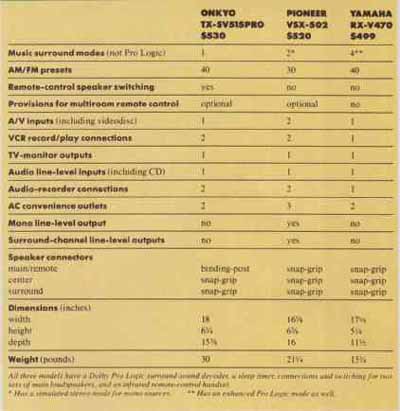
= = = =
The remote control sup plied with the VSX-502 was one of the more bewildering ones I have encountered. In addition to a stripped-down set of receiver controls, it has basic function buttons for a CD player, laserdisc player, TV, cassette deck, and VCR, all in a handset with only thirty- six buttons. (No word from the manual as to what brands of auxiliary equipment can be controlled—presumably only Pioneer’s.)
All the receiver-oriented buttons worked fine, but several of them have two different functions determined by the infrared equivalent of a typewriter or computer shift key, here a switch sliding between AUDIO and VIDEO positions. To balance channel outputs in a Dolby Pro Logic setup, for example, you have to keep sliding that switch back and forth while making adjustments with the single pair of plus and minus buttons. That wouldn’t be half so bad if the labeling on the handset weren’t so vague about which label belongs to which button with which shift setting. Don’t expect to figure this remote out quickly. I’d have gladly given up all ability to control other components with this handset to have had a separate button for every vital receiver function.
The lab results show that the VSX 502 was the powerhouse of the three models tested, delivering more than 4 dB greater continuous output than either of the others into 4-ohm loads. Its dynamic headroom was also quite respectable. But there was a problem at the other end of the dynamic range:
Even without Dolby Pro Logic or any other signal processing switched in, the VSX-502’s noise level was great enough to be clearly audible in a moderately quiet listening room. Even more obvious was the hissy 10-dB worsening of the noise level when we switched in either Simulated Surround or Simulated Stereo. Noise in Pro Logic mode was about 10 dB higher than in the other two receivers, but because movie soundtracks tend to be somewhat noise-prone themselves, that difference was less apparent in use than on the test bench. The Pioneer’s Pro Logic steering performance seemed to be fine.
Stereo FM pilot-carrier leakage was also on the high side, and we would have preferred a horizontal arrangement of the back-panel connections rather than a vertical one, but these are minor matters. The main question you face with the VSX-502 is whether its substantial power advantage over the other two receivers (especially into low impedances) is worth the sacrifice in signal-to-noise ratio, which, with music at least, is likely to be more noticeable most of the time than differences in maximum output power.
= = = =
LABORATORY MEASUREMENTS
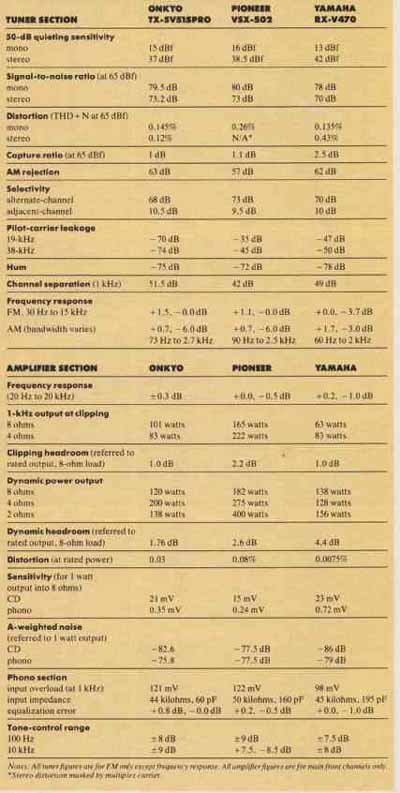
= = = =
DOLBY PRO LOGIC MEASUREMENTS
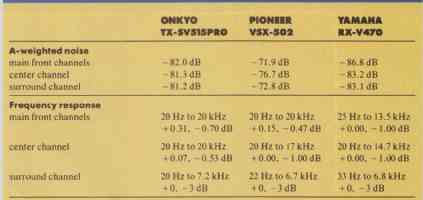
= = = =
Yamaha RX-V470
To my eyes, the RX-V470 is the best looking of these three receivers. It is certainly much the smallest, and that, combined with its refreshing lack of front-panel button clutter, makes for a less imposing, more “friendly” feel. After the heft of the other two receivers, the RX-V470’s light weight is immediately striking. The difference stems primarily from its smaller power transformer, which in turn indicates that it is a lower-powered receiver than the other two. This is visible in the lab results for 1-kHz output at clipping. But don’t concentrate too much on this measurement. A more important one is actually the dynamic power output, which at 138 watts into 8 ohms indicates that the RX-V470 is capable of playing music peaks quite loud enough for most purposes with speakers of typical efficiency (for ex ample, it can generate peaks of Ill dB sound-pressure level at 1 meter with speakers rated at 90-dB sensitivity).
The RX-V470 has slightly fewer basic features than the other models, but the main sacrifices, only one VCR and one audio recorder hookup, aren’t significant unless you plan to hook up more than one of each of those components. The remote control is okay. Although the buttons are all the same size and arrayed in too regular a pat tern, the markings are clear and fairly legible even under dim lighting conditions. And there is a logical pattern to the button layout that helps in memorizing the functions.
I sorely missed a couple of functions on the handset: level setting for the center and surround speakers. Al though you ordinarily have to make a front/center/surround balance adjustment only when you replace any of the speakers or make substantial changes in speaker positions or room acoustics, it is always best to make the level- matching judgments from the prime listening position. With the RX-V470 you need a partner, or a sound-level meter, to listen while you turn the front-panel center and “rear” level knobs. (Yamaha definitely recommends putting the surround speakers at the rear rather than on the sides of the listening room.)
More significant, especially given the receiver’s four music-enhancement modes, is the remote’s lack of control over the surround-speaker level and the amount of enhancement signal fed to the front channels. For best results with any of the music- enhancement modes (which add different complex clusters of delay-generated “reflections” to the front and rear surround channels when activated), you should have control over the level of the synthesized reflections, their front-to-rear balance, and the delay until the first reflection is generated. The Yamaha remote has only the last of those controls, making the most creative and sonically apt use of the music modes just about impossible without a lot of scurrying back and forth between the receiver and the primary listening position.
Nevertheless, the mode settings we wound up with after carefully per forming the Dolby Pro Logic setup procedure were good, if not ideal. At times, the echoes that the music modes added to the front-speaker sound made the front image too spacey or distant. Such a result can be alleviated simply by turning the Front Effect control down or all the way off.
Each music-enhancement mode produced a slightly different effect, and the effects often worked well with musical genres other than those implied by their names: Concert Video, Mono Movie, Rock, and Hall. I’d en courage experimentation with different modes and delay times. The slight “cognitive dissonance” caused by placing the surround speakers at the rear can be cured by putting them where they should be, on the sides, and letting the music-mode reflections fall where they may. When we tried that, the sonic results weren’t bad at all. I found the “enhanced” Dolby Pro Logic mode—which adds reflections to simulate the acoustics of a large movie theater—distracting and unnecessary, as I’ve always found similar settings on other models. You’re better off sticking with straight Pro Logic for surround-encoded soundtracks and using the music modes where appropriate for standard two-channel stereo recordings.
Aside from the “missing” controls on the remote, the RX-V470 is very easy to use, and its multiple surround options provide great flexibility in shaping the sound field. And, though not the powerhouse of the group, it delivers adequate output, especially for small or medium-size listening rooms.
By now it should be clear how the design tradeoffs shake out among these products. The Onkyo TX-SV515PRO combines relatively high power with a good array of input connections and fine surround performance, but it has only one rather staid, safe, and unexciting music-enhancement mode. The Yamaha RX-V470’s more complex digital circuitry provides four well-crafted music modes (the best selection in this group of receivers), which can make for interesting musical experimentation, but the power available is modest, and the remote is underequipped to take full advantage of the processing circuitry. I’d recommend the RX-V470 for those who are primarily interested in listening to music but occasionally want to hear an episode of Saturday Night Live or a rented movie in surround sound. Pioneer’s well-appointed and truly high-powered VSX-502 is noisier than we’d like in this age of the CD, but if your main interest is hearing movie soundtracks played loud, it could be a good choice.
= = = USING DOLBY PRO LOGIC = =
Most regular readers of STEREO REVIEW already know the basics of using a Dolby Pro Logic decoder for reproducing Dolby Surround soundtracks. Just follow these simple guidelines:
• If possible, use a center-channel speaker for maximum clarity and solid dialogue placement at the screen.
• Place the surround speakers above and to the sides of your prime listening position rather than in back of it. (Despite the nomenclature often adopted in manuals, equipment labeling, and promotional literature, the sound of the ‘rear” channels is supposed to come primarily from the sides, as It does in a movie theater).
• Balance loudspeaker levels very carefully—even to the extent of employing a sound-level meter (Radio Shack has one for $31.95, catalog number 33-2050)—— using the test-signal generator required in all Dolby Pro Logic devices. You can make a great difference in the overall sonic impression of a soundtrack by very slight adjustments in the front/center/surround balance.
There is another point that has not been emphasized enough and that our lab tests have revealed as a potential problem:
Dolby Pro Logic circuits are susceptible to overload. In itself, that’s no cause for great alarm. All circuits, if driven hard enough, will overload. The important point is that you can do nothing about a Pro Logic circuit’s overload point by changing any of the normal front-panel settings. Neither the overall volume control nor the individual level controls for the center and surround speakers have any effect on the Pro Logic overload point, because those controls all come after the decoder in the signal path.
In general, Pro Logic overload points are set high enough so that the lull output of a laserdisc player (approximately 2 volts) will not strain the system. But you should never insert into the signal path between a laserdisc player and a Dolby Pro Logic circuit any device that changes the level of even part of the signal. Equalizers in particular are best switched out or placed somewhere later in the signal chain. The manual for Pioneer’s VSX-502 can speak for them all when it clearly states that “Dolby Surround will not operate correctly it the signal passes through a graphic equalizer.” VCR and TV-receiver audio outputs are usually lower in level than those of laserdisc players. But even though overload potential would be less of a consideration with such components, the same restriction applies to them, too, since the directional enhancement that Pro Logic is designed to provide can be thrown off by the response changes introduced by equalizers.
One last point: The use of the word “digital” with regard to Dolby Pro Logic decoders has become a little too loose lately. Of the three receivers reviewed here, only one, the Yamaha RX-V470, actually incorporates what might truly be called a digital Pro Logic circuit—one in which the signal steering to the various channels is controlled by numerical calculation. The other two receivers use good analog circuitry for signal steering in conjunction with delta-modulation digital delay lines for the required surround- channel delay and their music- enhancement modes.
Even the Yamaha Pro Logic system, although more fully digital than the others covered here, doesn’t seem to use CD-type 16-bit PCM analog-to-digital conversion in its delay circuit. Lab tests have indicated that fewer than 16 bits are used in a “floating-point” conversion system, and that was evident in the rise and fall of the surround-channel noise levels as the input signal changed level. And Yamaha’s Pro Logic steering is accomplished not by adding and subtracting signals in digital form but by mixing them in analog form through digitally controlled attenuation circuits. The use of the word “digital” to describe this circuitry is technically correct, then, but it does not mean what you might ordinarily expect.
[Also see Kenwood KC-X1 tuner/preamp review]
From: Stereo Review (June 1993)